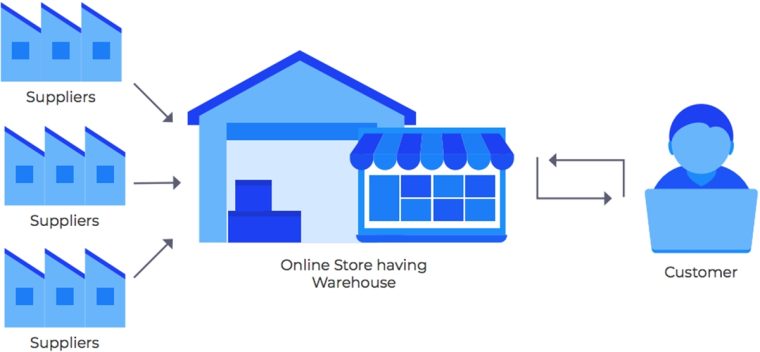Wholesale, a term often heard but not always fully understood, plays a pivotal role in the global economy. It’s the invisible force driving products from manufacturers to the hands of consumers.
Diving into wholesale means exploring the complex yet fascinating journey of goods as they navigate through various business layers.
This exploration is not just for industry veterans but for anyone curious about the backbone of retail operations.
Key Takeaways
- Understanding the Wholesale Meaning: Grasping the concept of buying and selling goods in bulk to retailers and other entities.
- Challenges in Wholesale: Recognizing the hurdles in marketing, inventory management, and logistics.
- Wholesale Pricing Dynamics: Unraveling how pricing is set in the wholesale world and its impact on retail
- Cost Considerations: Delving into the factors that influence wholesale pricing, from raw materials to market competition.
What Is Wholesale?
The wholesale meaning refers to the sale of goods or services in large quantities to be resold by a retailer.
Wholesalers purchase products from manufacturers in bulk for a low price per item and sell smaller quantities to retailers for a profit, who then market them to consumers.
How Does the Wholesale Business Model Work?
Wholesalers serve as intermediaries between manufacturers and retailers. They buy products at a discounted price as they make high-volume purchases.
The wholesaler then sells the products in smaller quantities at a markup to retailers.
However, the wholesale price is still lower than what the retailer will charge consumers. This allows the retailer to make a profit while also passing on some of the wholesale discounts to consumers.
Recently, it has become drastically easier to reach end customers with online stores and digital marketing, cutting the need for some wholesalers to use retail partners to sell their goods.
This model doesn’t technically fit under the definition of wholesaling but it has most of the same benefits while cutting out another middle man. The downside is that you have to do the marketing and sales work yourself.
Wholesalers may focus on a specific product category, such as electronics or apparel, or offer a wide selection of goods. They provide vital distribution and logistics services like warehousing, delivery, and inventory management for retailers. Wholesalers sometimes also offer marketing guidance, sales support, and product expertise.
Types of Wholesale Models
There are a few main wholesale models:
- Merchant Wholesalers – Take ownership of inventory and sell a variety of products to many retailers. Offer services like warehousing and delivery.
- Agents and Brokers – Act as intermediaries between buyers and sellers. Do not take ownership of goods. They earn a commission on the sales they facilitate.
- Manufacturers as Wholesalers – Producers can also distribute and sell products directly to retailers. This puts them in direct competition with traditional wholesalers.
- Specialized Wholesalers – Focus on specific product categories, market segments, or geographies. They develop deep category expertise and form long-term partnerships with both manufacturers and retailers.
Advantages of Wholesaling
Wholesaling benefits the wholesaler as well as both ends of the supply chain.
For manufacturers, wholesalers provide an efficient distribution channel without the need for extensive sales operations. Wholesalers also give retailers access to a wider selection of inventory from multiple vendors.
Other advantages of wholesaling include:
- Cost Savings – Bulk purchasing allows for better prices, improving profit margins for the wholesaler.
- Convenience – Retailers can obtain many products from a single wholesaler.
- Category Expertise – Specialized wholesalers sometimes offer valuable product knowledge.
- Warehousing – Wholesalers usually handle storage and inventory management.
- Transportation and Logistics– Wholesalers can provide product transportation and logistics services.
Challenges in Wholesale
The wholesale business model comes with some difficulties for the owners, including:
Marketing and Brand Consistency Issues
Unlike direct-to-consumer marketing, wholesalers must navigate the delicate balance of promoting their products while maintaining brand consistency across different retail platforms.
Retailers, driven by their agendas, might not align perfectly with a wholesaler’s brand vision, leading to potential discrepancies in product portrayal.
This dissonance requires wholesalers to take a proactive stance in marketing, ensuring that their brand message remains coherent regardless of the retail environment.
Inventory and Capital Risks: The Burden of Unsold Stock
A significant risk in wholesale is the inventory gamble. Once a wholesaler purchases stock, it becomes a race against time to sell it before it becomes a financial burden. This bulk buying, although economical per unit, requires substantial upfront investment. Unsold inventory translates into tied-up capital, lost storage space, and sometimes, depreciating goods value. It’s a high-stakes game where market demand predictions play a crucial role in inventory decisions.
The Necessity of Ample Warehouse Space and Efficient Logistics
Wholesaling is not just about acquiring and selling products; it’s also about where and how you store them. Ample warehousing is crucial for managing large inventories.
However, space alone isn’t enough.
The efficiency of warehousing operations, from organizing to dispatching goods, can make or break a wholesaler’s success. Poorly managed logistics lead to delays, errors, and ultimately, dissatisfied customers and retailers.
Efficient logistics are the lifeblood of wholesale operations.
Wholesale Pricing and Profit Margins
Wholesale pricing forms the foundation of the retail pricing structure.
It’s the cost at which retailers purchase products in bulk from wholesalers. The key is that these prices are significantly lower than retail prices, allowing room for retail markup – the process of increasing the product’s price when sold to the final consumer.
This markup covers retail overheads and ensures profit.
Essentially, wholesale pricing dictates the market’s overall pricing rhythm.
Factors Influencing Wholesale Pricing
Determining wholesale prices is a nuanced process influenced by various factors:
- Raw Material and Labor Costs: The foundational expenses in creating a product.
- Overhead: These are the operational costs, including warehousing, utilities, and staff.
- Shrinkage: The loss of inventory due to damage, theft, or mismanagement.
- Competitor Pricing: Understanding market competition is crucial. Pricing too high might drive away potential retailers, while pricing too low could harm profit margins.

